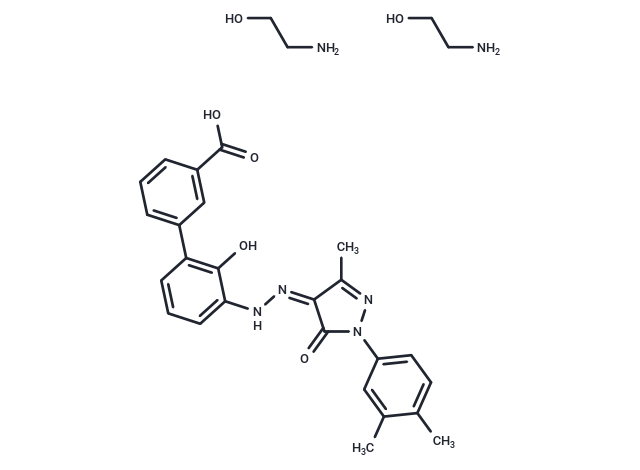Shopping Cart
- Remove All
 Your shopping cart is currently empty
Your shopping cart is currently empty

Eltrombopag Olamine (Eltrombopag diethanolamine salt) is an orally active small-molecule, nonpeptide thrombopoietin receptor agonist that stimulates megakaryopoiesis. It binds to and activates the transmembrane domain of the platelet thrombopoietin receptor (TPO-R or CD110), promoting the proliferation and differentiation of megakaryocytic cells and enhancing platelet production.

| Pack Size | Price | Availability | Quantity |
|---|---|---|---|
| 2 mg | $36 | In Stock | |
| 5 mg | $58 | In Stock | |
| 10 mg | $92 | In Stock | |
| 25 mg | $143 | In Stock | |
| 50 mg | $187 | In Stock | |
| 100 mg | $242 | In Stock | |
| 200 mg | $358 | In Stock | |
| 500 mg | $593 | In Stock | |
| 1 mL x 10 mM (in DMSO) | $83 | In Stock |
| Description | Eltrombopag Olamine (Eltrombopag diethanolamine salt) is an orally active small-molecule, nonpeptide thrombopoietin receptor agonist that stimulates megakaryopoiesis. It binds to and activates the transmembrane domain of the platelet thrombopoietin receptor (TPO-R or CD110), promoting the proliferation and differentiation of megakaryocytic cells and enhancing platelet production. |
| In vitro | Eltrombopag demonstrates a half maximal effective concentration (EC50) of 0.27 μM in murine BAF3 cells transfected with the luciferase reporter gene under direction of the STAT-activated IRF-1 promoter and human TpoR (BAF3/IRF-1/hTpoR). Eltrombopag activates the receptor by association with metal ions (i.e., Zn2+) and specific amino acids within the transmembrane and juxtamembrane domains of the TpoR. Eltrombopag (30 μM) results in activation of STAT5 in N2C-Tpo cells, as detected with an antiphospho-STAT5 antibody on Western blots. Eltrombopag stimulates proliferation after a 2-day incubation with an EC50 of 0.03 μM in a BrdU assay conducted in BAF3/hTpoR cells. Eltrombopag also induces differentiation of hematopoietic stem cells into committed megakaryocyte progenitor cells. Eltrombopag increases the differentiation of bone marrow CD34+ cells into CD41+ megakaryocytes in a dose-dependent manner with an EC50 of 0.1 μM. [1] Eltrombopag inhibits N2C-Tpo cell and HEL92.1.7 cell proliferating with IC50 of 20.7 μg/mL and 2.3 μg/mL. [2] Eltrombopag (20 μg/mL) leads to a decreased cell division rate, a block in G(1) phase of cell cycle, and increased differentiation in human and murine leukemia cells. Eltrombopag (5 μg/mL) shows clear signs of differentiation, significant changes in the organization of the nuclear contents, and an increase in the cytoplasm/nucleus ratio in HL60 cells. Eltrombopag (5 μg/mL) causes an increase in CD11b, which is consistent with a premacrophage state in U937 cells, and also causes an increase in CD11b in URE cells. Eltrombopag leads to a reduction in free intracellular iron in leukemic cells in a dose-dependent manner in HL60 cells. [3] |
| In vivo | Eltrombopag (10 mg/kg per day) increases platelet counts over twofold approximately 1 week after the last dose for one chimpanzee and approximately 1.5-fold for the other two chimpanzees. [1] Eltrombopag (1 mg/mL) prolongs survival in mouse models of leukemia. [3] |
| Kinase Assay | The high-performance liquid chromatography (HPLC) analyses are carried out using a Fast Acid Column (100×7.8 mm) and a HPX-87H Ion Exclusion Column (300 mm×7.8 mm) in series with 2.5 mM H2SO4 in water as the mobile phase at a flow rate of 0.3 mL/min, at 55°C. This method enabled quantification of D-glucose, ethanol, glycerol, D-xylulose, Ribitol, and xylitol. D-ribose, D-ribulose, and D-arabitol coeluted on the Aminex HPX-87H column. The CarboPac MA-1 column of Dionex ICS-3000 is used to analyze representative culture supernatant samples for the presence of arabitol and xylitol. Samples are run at column temperature of 30°C with 480 mM NaOH at flow rate 0.4 mL/min. The CarboPac MA-1 column separated D-arabitol from D-ribose and D-ribulose, but the alkaline conditions degraded D-ribulose interfering with the quantification of D-ribose.Yeast cells are disrupted with glass beads in 100 mM sodium phosphate buffer pH 7.0 containing phenylmethylsulfonyl fluoride and pepstatin A in final concentrations of 0.17 mg/mL and 0.01 mg/mL, respectively.The activity of NAD+-dependent Gdh2p is measured in a reaction buffer of 0.5 M triethanol amine pH 7.7 and 2 mM NADH. After addition of the cell lysate, the reaction is started by adding a mixture of α-ketoglutarate (100 mM) and NH4Cl (200 mM) to a final concentration of 2.4 mM and 4.9 mM, respectively. The GapB activity is measured. Shortly, the reaction mixture is 500 mM triethanol amine pH 7.8, 1 mM ATP, 2 mM MgCl2, 200 μM NADPH, and 10 μg/mL of phosphoglycerate kinase. 3-phosphoglycerate is added to a final concentration of 5 mM to start the reaction. Activity measurements are performed with a Cobas Mira Plus automated analyzer[2]. |
| Alias | SB-497115GR, SB497115, Revolade, Promacta Olamine, Eltrombopag diethanolamine salt |
| Molecular Weight | 564.63 |
| Formula | C29H36N6O6 |
| Cas No. | 496775-62-3 |
| Smiles | NCCO.NCCO.CC1=NN(C(=O)\C1=N/Nc1cccc(-c2cccc(c2)C(O)=O)c1O)c1ccc(C)c(C)c1 |
| Relative Density. | no data available |
| Storage | Powder: -20°C for 3 years | In solvent: -80°C for 1 year | Shipping with blue ice. | |||||||||||||||||||||||||||||||||||
| Solubility Information | DMSO: 82 mg/mL (145.23 mM), Sonication is recommended. Ethanol: < 1 mg/mL (insoluble or slightly soluble) H2O: < 1 mg/mL (insoluble or slightly soluble) | |||||||||||||||||||||||||||||||||||
Solution Preparation Table | ||||||||||||||||||||||||||||||||||||
DMSO
| ||||||||||||||||||||||||||||||||||||

Copyright © 2015-2025 TargetMol Chemicals Inc. All Rights Reserved.